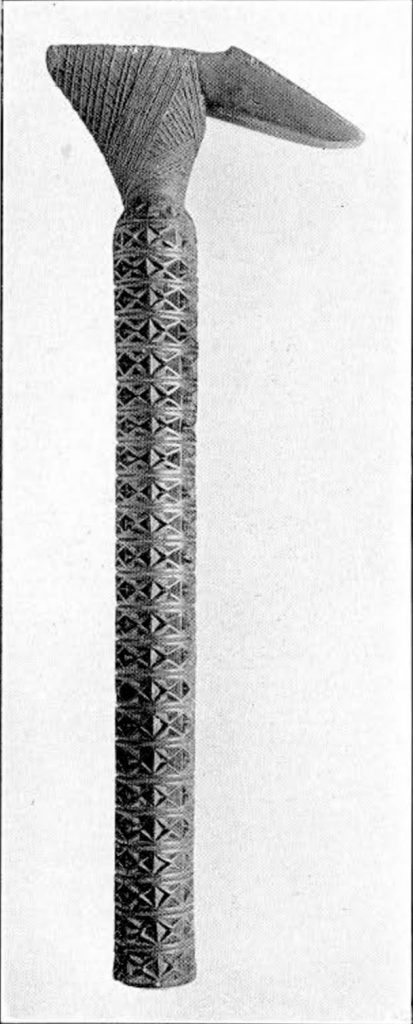Among the objects belonging to the same group and to the same collection as those from New Zealand, which were described and illustrated in the June number of this journal, are also some weapons and implements from Samoa, Hervey Islands, Austral Islands, Tonga,- and one most interesting club from the Marquesas, which will here be brought to your attention.
The islets mentioned above all belong, together with New Zealand and others, to the Polynesian group of the South Pacific, and to be able to duly appreciate the beautifully shaped and carved war-clubs, paddles, and adzes, which are here illustrated, it will be necessary to bear in mind some few facts about the people to whom they once belonged.
Nearly all the islands on which they live are small. Some of them are mountainous with lofty peaks rising above the clouds, and, on account of their volcanic character, many of the mountains are broken into a thousand fantastic shapes of great beauty and wildness; other islands are low coral structures rising but some few feet above the ocean, and others again have moderate elevation.
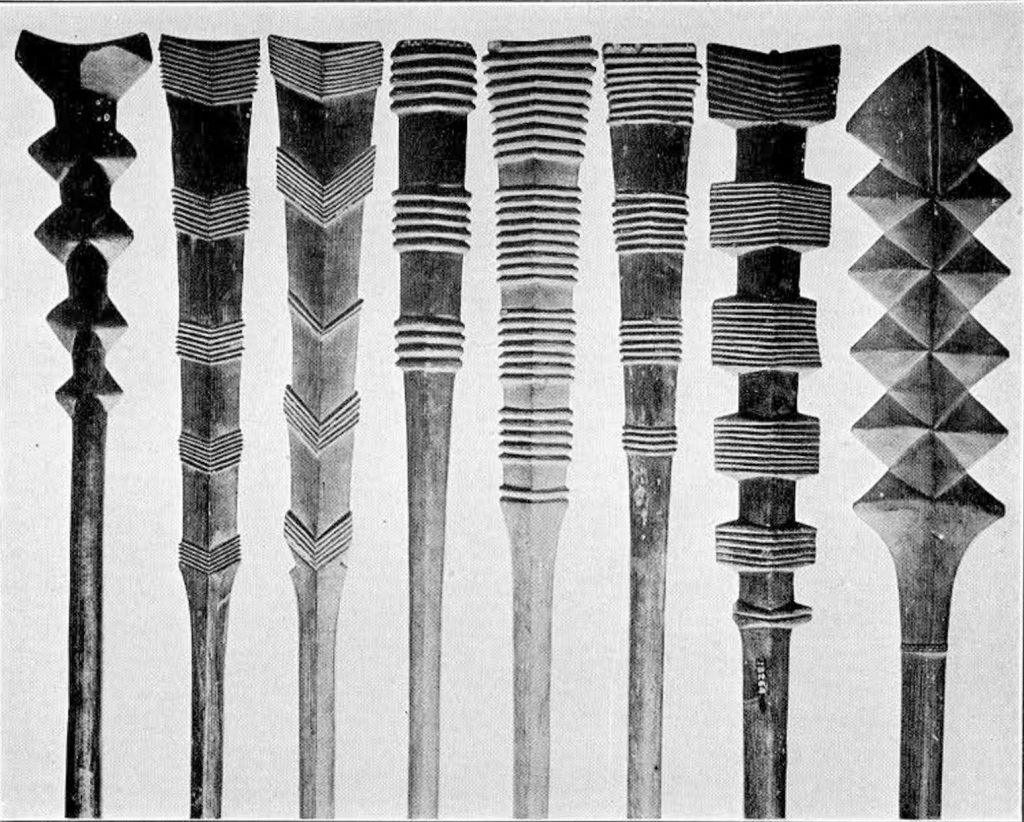
Museum Object Numbers: P2275 / P2279 / P2278 / P2274 / P2277 / P2276 / P2273 / P2372
Image Number: 176
Most of them have profuse vegetation of cocoanut palms, breadfruit trees, taro, banana trees, and several other utilitarian plants, which make life among the Polynesians rather easy; but this whole area, together with Australia, America, and the Arctic, was, when it was first discovered, yet in the stone age. There is no reason to believe, if there had been metals on these islands that the Polynesians should not have discovered how to use them, but there were none, and when we admire the skill and dexterity with which their objects are shaped, carved, and polished, we must not forget that it was done with tools of stone, bone, shell, teeth, or wood. George Turner, who lived with the Polynesians for a great number of years, tells that it might take them about one month to fell a tree with their stone axes. When we then remember all the work which is lavished on each particular paddle or club, we easily realize that it must have taken a very long time to do it. Such an object when finished was not to the owner as to us a curiosity, through which may be traced relationships between this island and that, and connections between these islanders and their native home, or consanguinity between them and the Redskins.
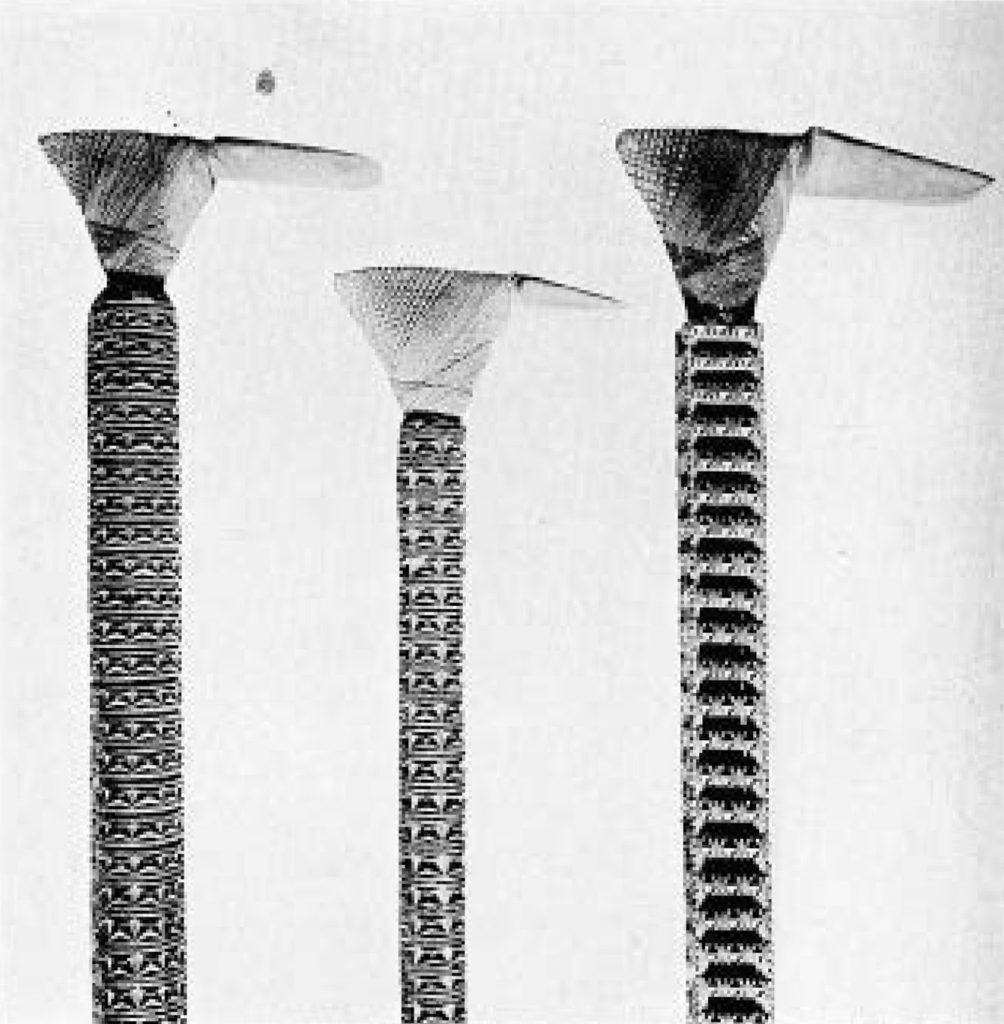
Museum Object Numbers: P2253 / P2153 / P2148
Image Number: 56
No, the relation of the Polynesians to their implements was one of much greater intimacy, because in many cases it was like that of the maker to his workmanship, or even as that of the inventor to his creations. They were children of his brain, shaped and modified to suit utilitarian purposes, carved and polished to gratify his artistic fancy and to bring forth the admiration of his comrades.
And to excite their admiration he had to adhere to their established conventions to speak in their language so to say, and yet to bring forth a product in which the conventional form was intensified, improved, or after their taste made graceful. And he knew how many sections he had made, and how many incisions in each, and how long a time it had taken him to do it, and finally he had grown accustomed to his products in use. All this, I have no doubt, would help him to understand the feeling of the Creator towards the earth he had made. It is said that He rested, and looked at His creation and saw that it was well done, and His affection towards it was great.
Samoan War and State Clubs.
Baugainville’s expedition was the first to visit the Samoan islands. They called them “Navigators’ Islands,” because the people moved about so much in canoes. The origin of Samoa as a name is native, and came about in the following manner. The god of rocks had a son with earth. They called him Moa, which means center of earth. His father made rocks and earth and all things that grow, saia Moa or sacred to Moa till his hair was cut. When this happened the restriction was removed, but the name clung, and since then earth and rocks and things that grow have been called saia Mon, which is abbreviated Samoa. It was the year 1768 that Baugainville visited these shores, and afterwards several expeditions landed and finally in 1830 a missionary station was started. The Samoans did not like their visitors, and we know that in those times, when the head of a family prayed to the household deities, he begged: “Drive away from us sailing gods, lest they come and cause disease and death.” But their deities were deaf to these prayers, and their civilization, customs, and beliefs had to flee before ours, until but very little is left, and of that little the objects that are here illustrated bear witness. The Samoan war club is about three feet long and made of very heavy, tough wood.
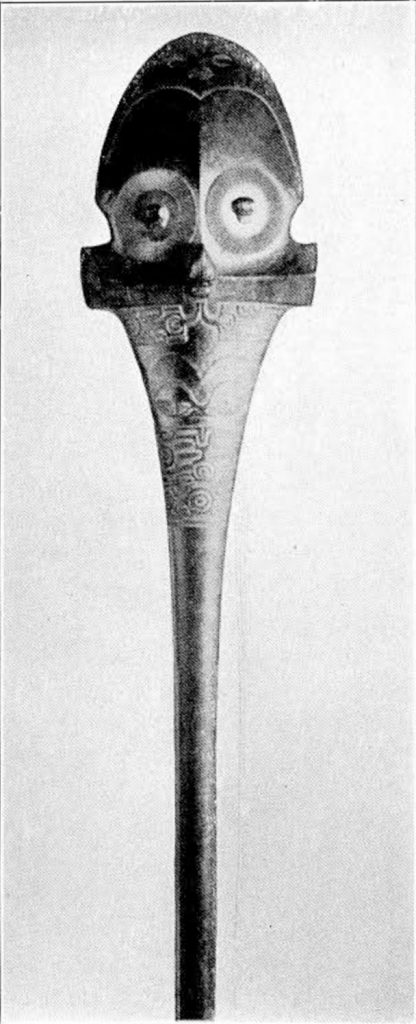
Museum Object Number: P2159
Both edges are sharp, the handle is well rounded and polished, and the whole weapon is very well adapted to use. It is uncommonly void of decorations, and the only thing which we may regard as such is the cross and middle rib which runs through the whole length and breadth of the blade, but the shape is light and pleasing.
Turner tells that the chief causes for wars in Samoa were murders, disputes about titles, or vanity (one chief wanting to show that he was mightier than another). Sometimes the parties arbitrated by paying fines, by carrying firewood, stones, and leaves, such as were used for roasting a pig, or by carrying bamboo knives. The two last acts signified submission and were interpreted as: “Here we are, your pigs, to be roasted if you please,” and “we have come, and here are the knives to cut us up with.”

Museum Object Number: P2150
Image Number: 58
If the war was insisted upon the women and the children, the sick and aged were brought to safety and then no lives were spared. Wives of chiefs and prominent men followed their husbands in war, carrying their clubs and tending them if sick or wounded.
Fig. 46 shows a row of Samoan state-clubs, carried on festive occasion. All these are beautiful in shape but the decorations are remarkably simple and stronglined for Polynesia, a fact which we will easily realize when we look at the very delicate carvings on the Figs. 47, 48 represent four adzes from Magaia Island in the Hervey group. The wonderfully carved handles look like lacework and suggest frailty, but when we actually handle the objects we find that the handles are made of solid wood, and though the carvings are deep, pretty, stout kernels are left, the heavy black stone heads rest in grooves, and the symmetrical fastenings of native, plaited string hold them firmly. The wood in the handles is lighter than that of the Samoan clubs, and yet not too light to make of these adzes quite effective implements, but in Fig. 50 we find a sample of the same type of weapon, in which size us well as decoration has been carried to such extreme as to actually make it unpractical. Such adzes were used for symbolic purposes.
Austral Islands Paddles.
Most beautiful were the carved paddles of the Austral Islanders (Figs. 51, 52, 53), and if we look closely at the fine carvings and tracings we find an infinite number of variations in design and combination. It will be seen that of seven shown in the illustrations no two are alike. What significance these infinite variations had to the native mind is yet to be worked out; but we may take for granted, that they were not there without reason. It would seem as if some of them had a local significance and mark the products of different islands of the group.
Tonga State Clubs.
Nothing in the whole valuable collection may more strongly impress us with the wonderful cleverness and ability of the Polynesians in handling their primitive tools than the objects shown in Figs. 54 and 55. The shapes are varied and the designs, though almost exclusively composed of straight lines, so impressively alternated as to make an unusually pleasing impression. These handsome objects were obviously primarily designed as insignia of rank and can only exceptionally have been used for fighting. The whole club from handle to point is in each instance covered with carvings, and among the zigzag lines we may on many of them discover a crude human form as well as figures of stars, crescents, fishes, and tortoises which show how the whole life of Polynesia was imbued in a dignified manner with religious images, symbols and ceremonies.
Marquesas.
The specimen shown in Fig. 49 represents a characteristic paddle-shaped club from the Marquesas. It has, like almost every production of their artistic dexterity, a fantastically executed human countenance on either side of the blade. The wood is hard and tough, the whole object is highly polished and makes the impression rather to belong to the class of symbolic objects than to that of useful weapons.
Gerda Sebbelov
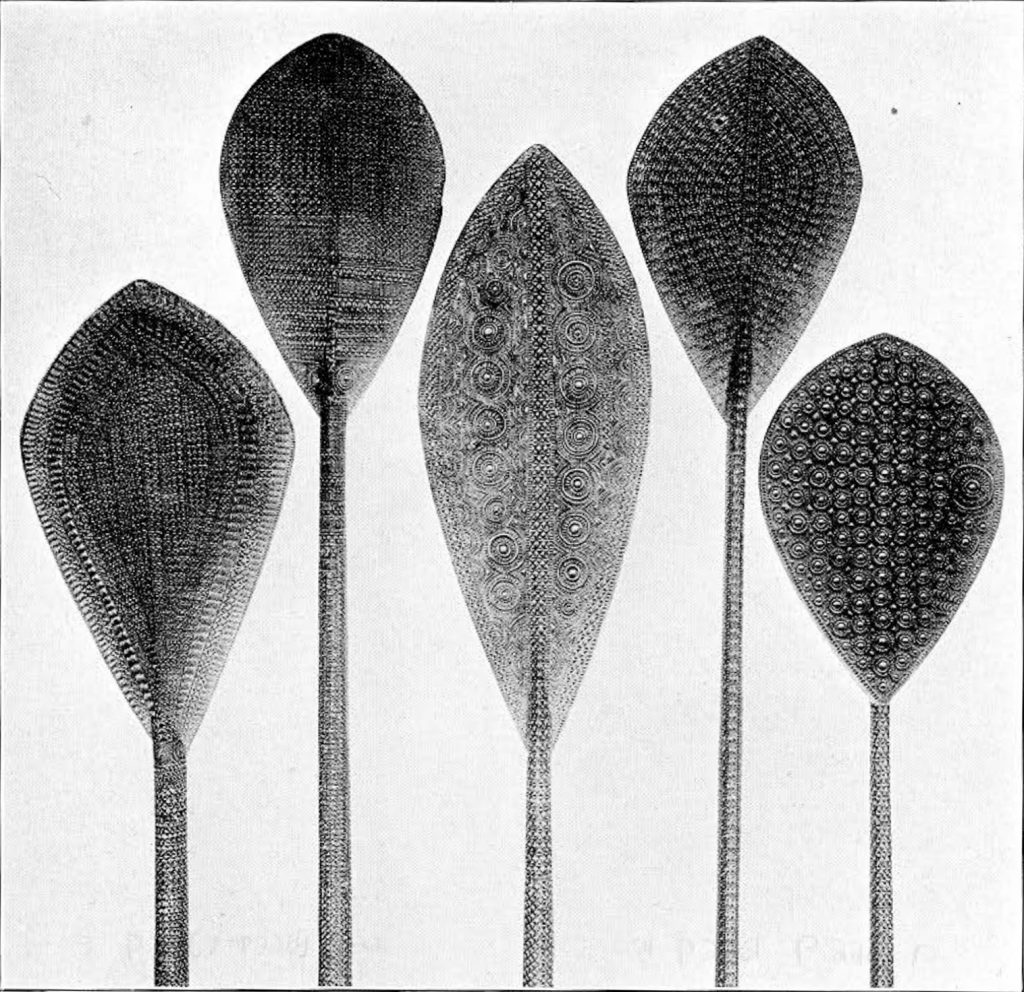
Museum Object Numbers: P2144 / P2145 / P2143 / P2146 / P2147
Image Number: 19


Museum Object Number: P2140
Image Number: 9
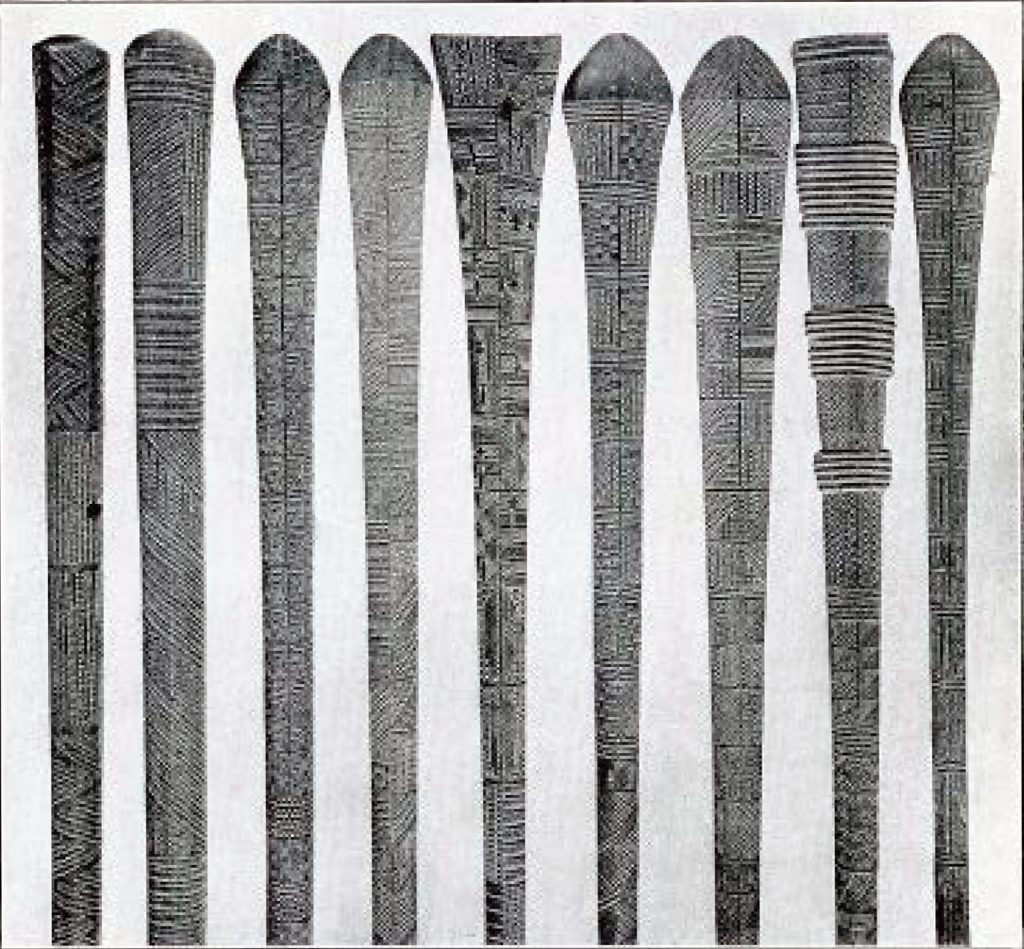
Museum Object Numbers: P2265, P2267 / P2268 / P2271 / P2270 / P2264 / P2266 / P2268
Image Number: 198
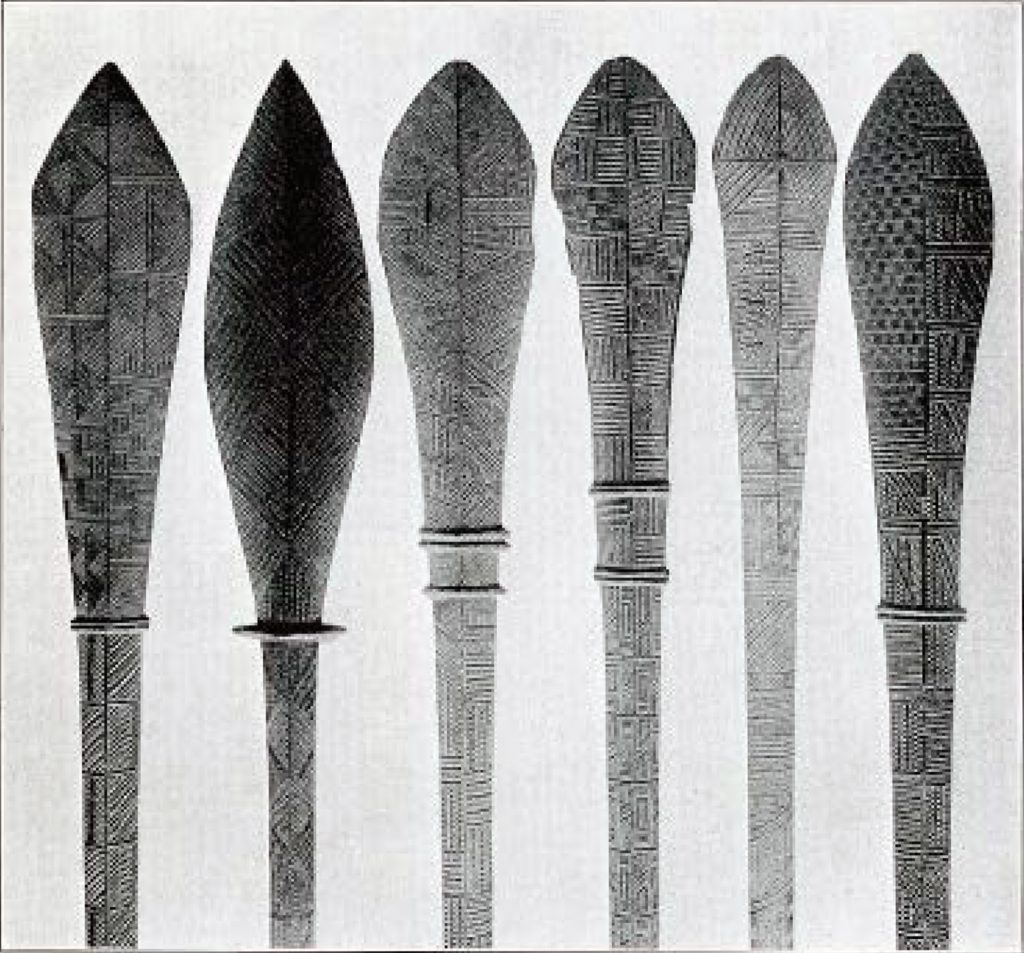
Museum Object Numbers: P2260 / P2262 / P2257 / P2258 / P2259 / P2256
Image Number: 199


